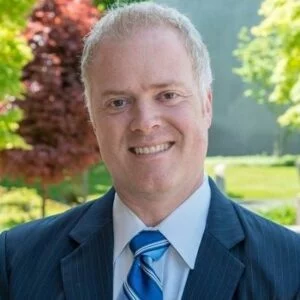Chris Gough of Intel and both Dr. Sanaz Cordes and Dr. Eric Quiñones of World Wide Technology (WWT) came together to showcase their hybrid cloud solution and their organizations' partnership.
With the locus of care changing to the home, there have been tactical and logistical challenges altering the mindset of health systems regarding to care. According to Dr. Cordes, it has typically been a mindset of episodic and reactive care that is now transitioning to a model of continuous patient care. In shifting to remote patient monitoring, data could be consistently captured and alert caregivers before drastic intervention is required.

Dr. Eric Quiñones, World
Wide Technology
Challenges have also arisen in the daily execution to make access to care possible, according to Dr. Cordes. For digital engagement, patient portals must have been set up successfully, a retail experience created, and remote engagement and connectivity made available for patients.
Dr. Cordes also explained that the accelerated pace created by the pandemic could continue. Even with relinquishing pressure in 2021, models of care like remote patient monitoring and telemedicine will continue to grow.
The experts discussed use cases where systems can utilize real-time data and intervention to move care to the home. According to Dr. Quiñones, a CMS acute care at-home program launched in March 2020, which allowed experienced hospitals to expand to Medicare beneficiaries.
Starting February 2021, Humana's Medicare Advantage population has in-network access to Mercy Virtual, a bedless hospital in St. Louis, Mo., which provides proactive care for patients at home. He also listed big technology companies like Amazon Care, Intermountain Health, and Ascension Health, who are lobbying to permanently alter home care reimbursement policies.
Dr. Quiñones additionally explained that there is a focus on chronic care conditions for real-time data tracking. By taking corrective action now, it can provide preventative care to keep patients with certain conditions.
"There's a lot of opportunities there to be more proactive with that population. Those are the kinds of conditions that I see this really getting in front of. For example, congestive heart failure, diabetes, hypertension – some of the most common conditions we see that we’re spending the most dollars on in healthcare - to be proactive with those patients and taking corrective action before they end up getting to a bad place and having to be whisked off to the ED," Dr. Quiñones said.
Microsoft and Intel engaged WWT to develop a hybrid cloud solution to demonstrate the power of Azure Stack Edge Pro's Edge Compute and AI technology. According to Gough, this stemmed from seeing a common need for an intelligent edge solution.

Chris Gough, Intel
"There's always going to be an edge in healthcare, that's where the patients are. That's where data is originally acquired," he said.
Gough explained some applications and use cases are more appropriately deployed in physical locations. A hybrid cloud solution assists health organizations in running specific applications and workloads at the point of care. It allows organizations to decide if they should run an application in the cloud.
With challenges like compliance, privacy, latency, and overwhelmed physicians, the hybrid solution identifies the signals from within the noise, Dr. Quiñones explained.
"Clinicians are slammed, and they're overwhelmed with the amounts of data that is humanly impossible to manage. It's sheer cognitive overload by numbers. Tools like this get the right data about the right patient to the right clinicians at the right time in order to be proactive and to be supportive in their critical clinical workflows," Dr. Quiñones said.
This tool configures chronic care management and post-discharge care populations, behavioral health, and rapid response teams. For real-time triage patients, it brings insights to clinicians so patients can be given the best level of care, according to Dr. Quiñones.
"A patient's decompensation driving early intervention leads to better outcomes and costs. All this can be done using your organization's clinical protocols," he said.
In January 2021, WWT was challenged to deliver a fully functional proof of concept by the end-of-February. It would be presented at the Microsoft Ignite Conference in March, according to Dr. Cordes. The team brought in physicians, nurses, data scientists, and more to work on an iterative model to identify use cases.
For the clinical use case, heart failure was chosen, which is the number one cause of death in the United States. According to Dr. Cordes, this model was chosen due to the data-rich environment, even though the solution would work in many clinical settings.

Dr. Sanaz Cordes, World Wide Technology
After creating protocols, they used AI and machine learning to analyze trends in order to take proactive steps. The hybrid solution helps scale and create greater optics for the patient and population longitudinal journey, Dr. Quiñones explained.
The Association of American Medical Colleges reported significant shortages; between 21,000 to 55,000 primary care physicians and between 34,00 to 87,00 in surgical and medical specialty positions by 2033.
"Clinical resources are thin right now. We see the numbers entering med school are starting to increase a little bit, but still, you can't train doctors or nurses overnight," Dr. Quiñones said.
And as the large generations continue to age, there are more chronic conditions to care for and a greater need for advanced technology is needed to fill the gap, he explained.
"I think this can have a tremendous impact on cost outcomes, patient satisfaction, and clinician experience," Dr. Quiñones said.
WWT collaborated with Washington University School of Medicine in St. Louis, Mo., for machine learning project that developed methods to predict cancer radiation treatments. With radiology oncology treatments becoming increasingly complex in necessary precision, they must be unique to the patient. And with time being a critical component of cancer care, Dr. Quiñones explained this partnership could alleviate delays in treatment.
The team created machine learning algorithms that quickly predicted optimal radiation oncology treatment orders. The platform gives specific details of the patient's cancer and provides radiotherapy planning, target volume, treatment frequency, and prediction percent with explanation.
"This has the potential to expedite a time-consuming process and radiology oncology orders with the goal of greater efficiency," hes said.
Some physicians remain reluctant to adopt technological advances like AI and machine learning, Dr. Cordes identified. However, she compared this to the path to adopting a CPOE order set and develop a workflow 15 years ago.
"There's nothing magical. It's the same kind of formula. We need to make sure that whatever solutions we bring forth--in this case, AI and machine learning--we're able to demonstrate a solid clinical ROI. Because that matters more than anything to the physician," she said.
According to Dr. Cordes, clinicians will become more comfortable with the adoption over time by measuring outcomes and metrics with these new solutions. By minimizing the level of disruption to the current clinical workflow, physicians can be increasingly receptive to solution adoption, Gough added.
"Physicians, nurses, and clinicians spend 10-12 hours a day on the electronic health record, that is their user interface. The thing I've learned over the decades is they don't want to open seven other apps. They do not want to have multiple user interfaces. Being workflow congruent is absolutely crucial," Dr. Cordes said.
To learn more about these solutions, visit wwt.com.